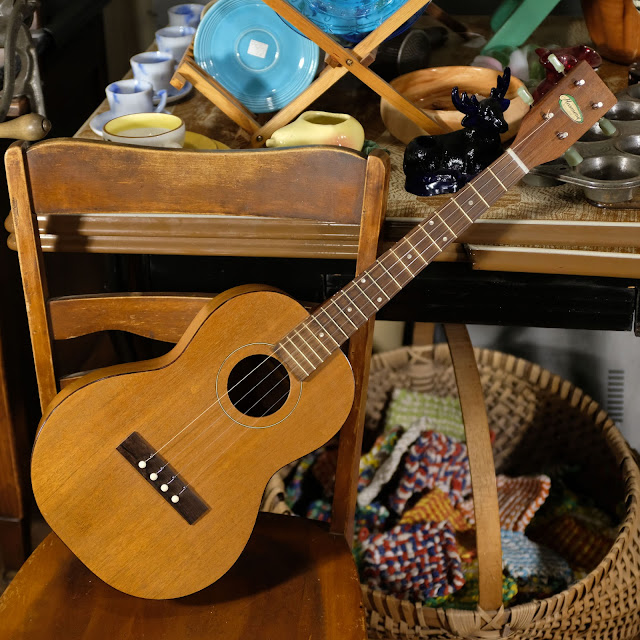1960s Harmony Bari-Uke-Itar Conversion
This is a consignor's mid-'60s Harmony baritone uke and it needed a bit of love and so I took it further. These '60s Harmony baris are built just a little heavier than their '50s counterparts and can often sound a little stiff. This one did, for sure.
After making it structurally pat (leveling/dressing the frets and securing the neck with a bolt internally) I swapped the tuners to guitar-style Kluson-a-like units, shaved the bridge plus made it pin-loading, and modified it like I do with tiple individual-screw-saddle setups. I then strung it up for low-G ukulele tuning (GCEA) using steel strings in very light gauges: 20w, 16, 12, 8. This is something I've done on tenor banjos in the past and I figured it would sound really good on this instrument. The tension is just a pound or three heavier than DGBE baritone nylon strings so I figured it couldn't hurt to try.
The result is a sweet little instrument that really works as a "uke-itar" and sounds, in some ways, similar to late '20s ladder-braced Gibson tenors. It's nice to have the familiar GCEA uke tuning and fingering but with guitar-style sustain and ring. It also plays very well with fingers and nails and, when strummed with them around the 12-14 fret zone, gives that same uke-like springy feel and timbre that a lot actual tenor guitars lack. A customer asked about DGBE tuning on this and my opinion is that at such a short scale (19 1/4"), that tuning often sounds a little dead or funky using steel strings. It works, but isn't as satisfying as the ring of a higher pitch.
There are no cracks but there's definitely some use-wear around the soundhole. The neck is straight, it plays with 1/16" action at the 12th fret, and the only other caveat is that the frets are very low at the extension over the body -- not that you'd be taking mad leads in that area, anyhow, on an instrument like this. Like a lot of Harmony baris, the extension of the fretboard shifts up there and that was taken-out of the frets during the leveling job.
The body is 10" on the lower bout and has a 3 1/2" depth.
This has the '60s-style atomic-looking Harmony logo.
The materials are all as usual for one of these: Brazilian rosewood board and bridge and solid mahogany everything else. The frets are brass and the nut is plastic with a 1 1/4" width. The neck profile is a mild-medium, fast D shape.
The dots are faux-pearl. I added side dots and you can see the sunk-in grunge of the fretboard.
The individual screw saddles are set at their properly-compensated points. They work best when the strings take a slight jag in their path -- thus terminating the vibrating portion of the string at the front of the "saddle." Because you can adjust them up or down, they give you -- in effect -- adjustable action height.
It's hard to see, but on the back of the heel there's a tiny filled hole where I pre-drilled for the internally-installed "neck bolt."
The binding is tortoise and the finish is a medium-tint brown that was originally "natural."














Comments